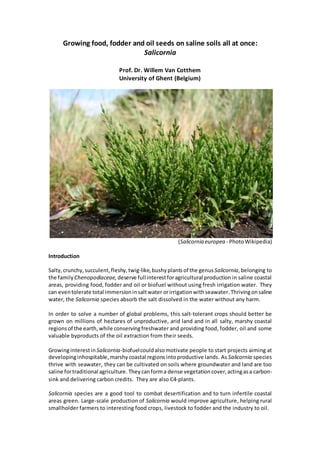
Growing food, fodder, oil on saline soils all at once salicornia
- 1. Growing food, fodder and oil seeds on saline soils all at once: Salicornia Prof. Dr. Willem Van Cotthem University of Ghent (Belgium) (Salicornia europea - PhotoWikipedia) Introduction Salty,crunchy,succulent,fleshy,twig-like,bushyplants of the genus Salicornia,belonging to the family Chenopodiaceae, deserve fullinterestforagricultural production in saline coastal areas, providing food, fodder and oil or biofuel without using fresh irrigation water. They can eventolerate total immersioninsaltwater orirrigationwithseawater. Thrivingonsaline water, the Salicornia species absorb the salt dissolved in the water without any harm. In order to solve a number of global problems, this salt-tolerant crops should better be grown on millions of hectares of unproductive, arid land and in all salty, marshy coastal regionsof the earth,while conservingfreshwater and providing food, fodder, oil and some valuable byproducts of the oil extraction from their seeds. Growinginterestin Salicornia-biofuelcouldalsomotivate people to start projects aiming at developinginhospitable,marshy coastal regions intoproductive lands. As Salicornia species thrive with seawater, they can be cultivated on soils where groundwater and land are too saline fortraditional agriculture. They canforma dense vegetation cover,actingasa carbon- sink and delivering carbon credits. They are also C4-plants. Salicornia species are a good tool to combat desertification and to turn infertile coastal areas green. Large-scale production of Salicornia would improve agriculture, helping rural smallholder farmers to interesting food crops, livestock to fodder and the industry to oil.
- 2. Salicornia has been grown successfully in different Arab states: the United Arab Emirates, Kuwait, Saudi Arabia, Egypt, etc, but also in India, Sri Lanka and Mexico. An improvedvarietyof Salicornia (SOS-10) isgrownextensivelyinseveral partsof the world. It growswell indesertsandsirrigatedwith seawater, butalsoalongthe seashore,e.g. in the mangrove belt. Characteristics of Salicornia (glasswort, samphire, pickleweed, …) Salicornia is a genus of many succulent halophytes, i.e. salt-tolerant plants that grow on beaches and in salt marshes. Different species are native to North and Central America, Europe, Northeast and South Africa and South Asia. Some common species are: CommonGlasswort, Salicornia europaea SlenderGlasswort, Salicornia maritima Dwarf Glasswort, Salicornia bigelovii Umari Keerai, Salicornia brachiata Purple Glasswort, Salicornia ramosissima American,VirginiaorWoodyGlasswort, Salicornia virginica They are annual herbs,growingupto 30 cm (1ft). Froma horizontal mainstemare sprouting a numberof green, erect,lateral branches,becomingred in autumn. Their scale-like leaves are very small, whereby the fleshy plant seems leafless. Hermaphrodite flowers are wind pollinated. The small, succulent fruits contain one single seed and the seeds ripen in autumn. Most Salicornias are edible, either raw or cooked, used as an accompaniment to fish or seafood dishes or added to soups. Propagation – Cultivation Some Salicornia speciesbelongtothe firstextensivelygrown crops irrigated with seawater. Up to now,two speciesof Salicornia have been commerciallycultivatedin different parts of the world: Salicornia bigelovii (dwarf glasswort) and Salicornia brachiata (Umari Keerai). Salicornia bigelovii grows in coastal belts and its seeds contain high levels of unsaturated oil (30 %) and 35 % protein. Salicornia brachiata is an erect annual herb, cultivated in India and Sri Lanka. Salicornia species grow on different soil types: sandy, loamy and clayey ones. The plants tolerate veryalkalineandsaline soils andsubmersion by seawater, but they prefer organic, sand and sandy loam soils and regular irrigation with seawater, even with that of the Arabian Gulf, which is saltier than most ocean water. Salicornia resists the highest salt concentrations to a maximum of 50,000 ppm. It can be protected from higher salt
- 3. concentrationsinthe soil by flushing the salt below the rooting zone and, if possible, back into the sea. Seawater contains sufficient quantities of other nutrients to make the need for adding fertilizers almost unnecessary. Therefore, it fulfills most of the nutrient needs of these succulentplants. In a number of tests, phosphorous was added and also urea as a nitrogen source. The bestplant formsforfoodproduction (edible plants) are erect,bushyplantselevating the branches above the mud. Seedsshould be collected from such plants. Plants growing close to the hightide line,receivinglessinundation,produce the bestseeds. As soon as they ripe, they are sown in situ in the cool season and they reach maturity and maximal production during the hot season. Since 1980, a selectionof Salicornia seedstook place to get progressively better-producing plants. Vegetative growth is achieved in about 100 relatively cool days. Maturity of the crop can be reachedin7 months andvery high yields of biomass have been harvested. One supposes that lowering the seeding density would produce fewer, but taller plants. Benefits The tender parts of some Salicornia species are traditionally used as a salad green or a vegetable withthe taste of spinach(inWesternEurope itissometimescalled Dutch Spinach or Sea Asparagus). They are eaten raw, cooked or pickled. However, because of the rising energy prices they are now cultivated for some other properties. High economic value is attributed to the somewhat 30 percent of edible oil in their seeds (more thanin soybeanseeds).Some ingredients of the oil are also used for the production of cosmetic and pharmaceutical substances. The remainingpulphasa highprotein content(40 percent),aboutthe same assoybean. This is a very positive factor for its use as protein feed for livestock, the plants being a good fodder or meal for cattle and a poultry-feed additive. The green biomass can even be ensilaged. The straw-pulp is basic material for the production of paper, board and mattresses. Dried, Salicornia can be crushed to make fuel briquettes. A dense Salicornia cover of saline land is seen as a good carbon-sink area, delivering more carbon credits. It has the potential for making the environment better.
